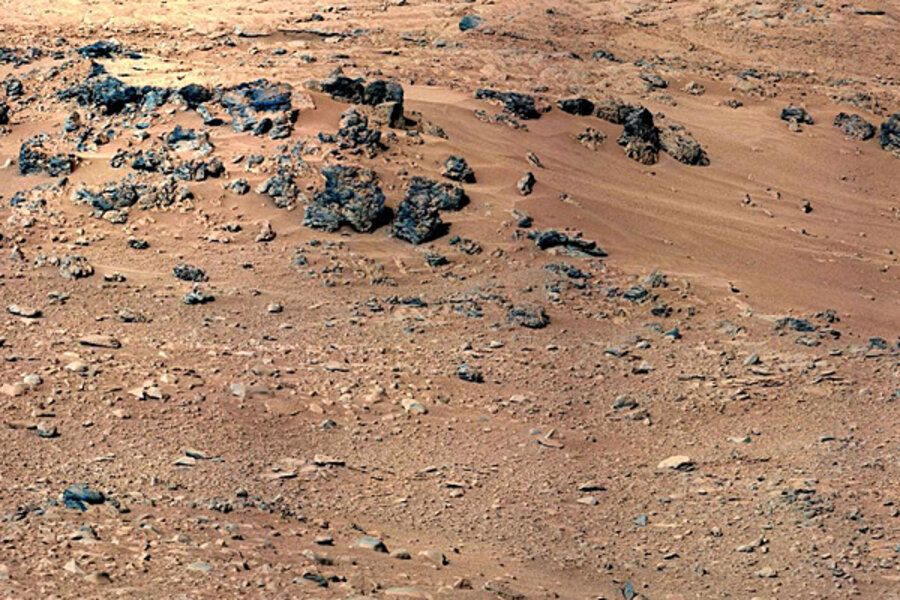Why a clean Mars rover is a happy Mars rover
Loading...
Two months and a just over half a mile into its mission, NASA's Mars rover Curiosity is taking time out for tests of key tools for sampling the Martian soil – and, it turns out, for some badly needed scrubbing.
Over the next two to three weeks, engineers will direct Curiosity to scoop sand from a stone-dotted mini-dune the team has dubbed Rocknest and to run it through sample-processing hardware dubbed CHIMRA.
It's a cleaning approach akin to a camper scouring the last meal's cookware with sand. After the scrubbing, NASA controllers plan to test CHIMRA's ability to feed samples collected by the scoop, and later Curiosity's drill, into two key instrument packages inside the rover’s chassis.
The clean-out is in preparation for the rover's main mission: analyzing rocks and soils to see if Gale Crater and its central summit, Mt. Sharp, once hosted an environment that could have supported life.
Curiosity's science team already has started to build a strong case for the presence of significant quantities of water flowing – at least periodically – through the crater billions of years ago. Water is a key ingredient for organic life.
Images released last week of rock outcroppings showed clear evidence they were formed from solidified silt and water-tumbled stones. The team's consensus interpretation: The feature represents the remains of a stream bed, perhaps uplifted and exposed by a small meteor that could have struck the spot.
The outcroppings appeared to be associated with the leading edge of a broad fan of sediment that on Earth forms as water carries soil and rock down mountainsides to lower elevations, where it spreads in what geologists call alluvial fans. In this case, the fan would have built as water flowed down now-eroded hills that form part of Gale Crater's rim.
After capturing such suggestive images, cleaning and more testing may seem a bit mundane. But it's necessary, says Daniel Limonadi, the lead systems engineer for the rover's sampling and science systems.
"Even though we make this hardware super-squeaky clean, just by virtue of being on Earth you get this residual, oily film that is impossible to avoid," he says.
It's also impossible for the rover's internal chemistry labs to avoid picking up on that residue in any samples CHIMRA delivers – contaminating the results. "So we're taking the sand samples and effectively using it to rinse out mouths three times and then kind of spit out."
The approach has all the subtlety of maracas. Once the scoop – a bit larger than a tablespoon – lifts the sand into CHIMRA, the device will vibrate by design to make sure the abrasive hits all the device's nooks and crannies. In normal operations, the strong vibrations are designed to move samples through sieves – with a final sample for analysis containing a tiny fraction of its original material.
The cleaning itself is expected to take about a week and a half, and when it's over, the scoop will deliver a fourth sample to the rover's internal instruments. One device, called CheMin, uses X-rays to analyze the mineral content of samples, while another, called SAM, uses ovens and solvents to analyze the detailed chemical make-up of the rock, including the presence of compounds containing carbon, one of the key chemical building blocks of life.
But Curiosity's longer stay at Rocknest speaks to the importance the science and engineering teams are placing on what mission manager Michael Watkins describes as "keystone" instruments.
"We're being deliberately, incredibly careful," he says. Every time CHIMRA, located on a turret at the end of Curiosity's robotic arm, takes a scoop, the team will be taking videos before, during and after each step of each gargle to ensure "we understand exactly what's going on." The goal is to take the time now to get to know how the instruments, tested on Earth, operate on Mars so these extra steps can be eliminated later in the mission.
"We're being extremely slow and prudent here," Mr. Watkins says.
Once the teams finish up at Rocknest, it's on to Glenelg, a confluence of three intriguing geological formations where the teams expect to use Curiosity's sampling drill for the first time.








